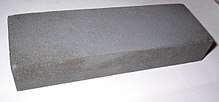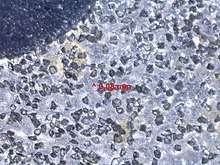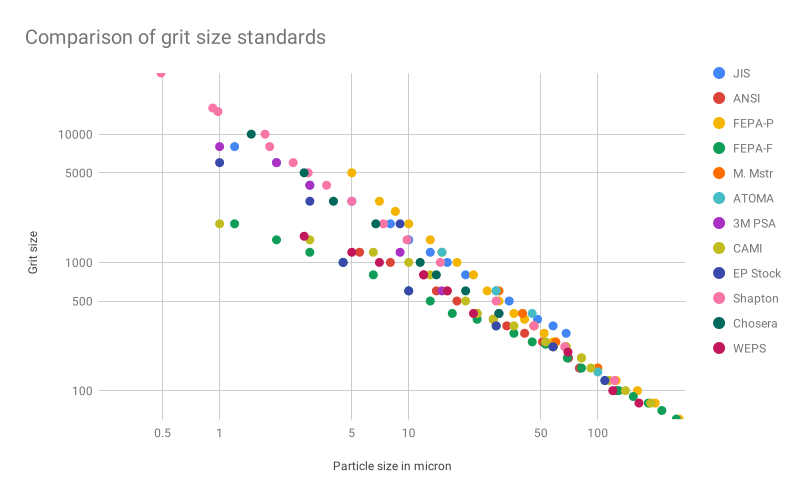Sharpening stone
Sharpening stones, water stones or whetstones are used to sharpen the edges of steel tools and implements through grinding and honing.

Examples of items that can be sharpened with a sharpening stone include scissors, scythes, knives, razors, and tools such as chisels, hand scrapers, and plane blades.
Sharpening stones come in a wide range of shapes, sizes, and material compositions. Stones may be flat, for working flat edges, or shaped for more complex edges, such as those associated with some wood carving or woodturning tools. They may be composed of natural quarried material, or from man-made material.
Stones are usually available in various grades, which refer to the grit size of the abrasive particles in the stone. Grit size is given as a number, which indicates the spatial density of the particles. A higher number denotes a higher density and therefore smaller particles, which leads to a finer finish of the surface of the polished object.
Terminology
Though "whetstone" is often mistaken as a reference to the water sometimes used to lubricate such stones, the term is based on the word "whet", which means to sharpen a blade,[1][2] not on the word "wet". The verb nowadays usually used to describe the process of using a sharpening stone is to sharpen, but the older term to whet is still sometimes used. The term to whet is so rare in this sense that it is no longer mentioned in for example the Oxford Living Dictionaries.[3][4] One of the most common mistaken idioms in English involves the phrase "to whet your appetite", too often mistakenly written as "to wet". But to "whet" quite appropriately means "to sharpen" one's appetite, not to douse it with water.
Natural stones versus artificial stones
The Roman historian Pliny described use of several naturally occurring stones for sharpening in his Natural History. He describes the use of both oil and water stones and gives the locations of several ancient sources for these stones.[5]
The use of natural stone for sharpening has diminished with the widespread availability of high-quality, consistent particle size artificial stones.
As a result, the legendary Honyama mines in Kyoto, Japan, have been closed since 1967. Belgium currently has only a single mine that is still quarrying Coticules and their Belgian Blue Whetstone (BBW) counterparts.[6]
Modern synthetic stones are generally of equal quality to natural stones, and are often considered superior in sharpening performance due to consistency of particle size and control over the properties of the stones. For example, the proportional content of abrasive particles as opposed to base or "binder" materials can be controlled to make the stone cut faster or slower, as desired.[7] Natural stones are often prized for their natural beauty as stones and their rarity, adding value as collectors' items. Furthermore, each natural stone is different, and there are rare natural stones that contain abrasive particles in grit sizes finer than are currently available in artificial stones.
One of the most well-regarded natural whetstones is the yellow-gray "Belgian Coticule", which has been legendary for the edge it can give to blades since Roman times, and has been quarried for centuries from the Ardennes. The slightly coarser and more plentiful "Belgian Blue" whetstone is found naturally with the yellow coticule in adjacent strata; hence two-sided whetstones are available, with a naturally occurring seam between the yellow and blue layers. These are highly prized for their natural elegance and beauty, and for providing both a fast-cutting surface for establishing a bevel and a finer surface for refining it. This stone is considered one of the finest for sharpening straight razors.
The hard stone of Charnwood Forest in northwest Leicestershire, England, has been quarried for centuries,[8] and was a source of whetstones and quern-stones.
Whetstones and oilstones
Whetstones may be natural or artificial stones. Artificial stones usually come in the form of a bonded abrasive composed of a ceramic such as silicon carbide (carborundum) or of aluminium oxide (corundum). Bonded abrasives provide a faster cutting action than natural stones. They are commonly available as a double-sided block with a coarse grit on one side and a fine grit on the other enabling one stone to satisfy the basic requirements of sharpening. Some shapes are designed for specific purposes such as sharpening scythes, drills or serrations.[9]
Natural stones are typically formed of quartz, such as novaculite. The Ouachita Mountains in Arkansas are noted as a source for these. Novaculite is also found in Syria and Lebanon, previously a part of the Ottoman (Turkish) empire, hence the use of the older name in America of Turkey stone.[10]
When the block is intended for installation on a bench it is called a bench stone. Small, portable stones (commonly made of bonded abrasive) are called pocket stones. Being smaller, they are more portable than bench stones but present difficulty in maintaining a consistent angle and pressure when drawing the stone along larger blades. However, they still can form a good edge. Frequently, fine grained pocket stones are used for honing, especially "in the field". Despite being a homophone with wet in most dialects of modern English, whetstones do not need to be lubricated with oil or water, although it is very common to do so. Lubrication aids the cutting action and carries swarf away.
Japanese waterstones

The Japanese traditionally used natural sharpening stones lubricated with water (using oil on a waterstone reduces its effectiveness). They have been doing this for many hundreds of years. The geology of Japan provided a type of stone which consists of fine silicate particles in a clay matrix, somewhat softer than novaculite.[11]
Japanese stones are also sedimentary. The most famous are typically mined in the Narutaki District just north of Kyoto.
Grades of waterstones
Historically, there are three broad grades of Japanese sharpening stones: the ara-to, or "rough stone", the naka-to or "middle/medium stone" and the shiage-to or "finishing stone". There is a fourth type of stone, the nagura, which is not used directly. Rather, it is used to form a cutting slurry on the shiage-to, which is often too hard to create the necessary slurry. Converting these names to absolute grit size is difficult as the classes are broad and natural stones have no inherent "grit number". As an indication, ara-to is probably (using a non-Japanese system of grading grit size) 500–1000 grit. The naka-to is probably 3000–5000 grit and the shiage-to is likely 7000–10000 grit. Current synthetic grit values range from extremely coarse, such as 120 grit, through extremely fine, such as 30,000 grit (less than half a micrometer abrasive particle size).
Diamond plate

A diamond plate is a steel plate, sometimes mounted on a plastic or resin base, coated with diamond grit, an abrasive that will grind metal. When they are mounted they are sometimes known as diamond stones.[12] The plate may have a series of holes cut in it that capture the swarf cast off as grinding takes place, and cuts costs by reducing the amount of abrasive surface area on each plate. Diamond plates can serve many purposes including sharpening steel tools, and for maintaining the flatness of man-made waterstones, which can become grooved or hollowed in use. Truing (flattening a stone whose shape has been changed as it wears away) is widely considered essential to the sharpening process but some hand sharpening techniques utilise the high points of a non-true stone. As the only part of a diamond plate to wear away is a very thin coating of grit and adhesive, and in a good diamond plate this wear is minimal due to diamond's hardness, a diamond plate retains its flatness. Rubbing the diamond plate on a whetstone to true (flatten) the whetstone is a modern alternative to more traditional truing methods.[13]
Diamond plates are available in various plate sizes (from credit card to bench plate size) and grades of grit. A coarser grit is used to remove larger amounts of metal more rapidly, such as when forming an edge or restoring a damaged edge. A finer grit is used to remove the scratches of larger grits and to refine an edge. There are two-sided plates with each side coated with a different grit.[14]
The highest quality diamond sharpeners use monocrystalline diamonds, single structures which will not break, giving them an excellent lifespan. These diamonds are bonded onto a precision ground surface, set in nickel, and electroplated. This process locks the diamonds in place.[14]

Grit size
There is no dominant standard for the relationship between "grit size" and particle diameter. Part of the difficulty is that "grit size" is used to refer to the smoothness of the finish produced by a sharpening stone, and not just the actual size of the grit particles. Other factors apart from particle diameter that affect the finish (and thus the "grit size" rating) are:
- the shape of the abrasive particles,
- how much of each particle is exposed by the binder,
- friability (whether the abrasive particles can be fractured into smaller ones by the pressure of grinding or polishing),
- the hardness of the abrasive particles, and
- the chemical composition of the abrasive particles (common abrasives include diamond, cubic boron nitride (CBN), chromium(III) oxide, tungsten carbide, silicon carbide and other ceramics).
In synthetic stones, the grit size is related to the mesh size used to select the particles to be included in the abrasive. Sandpaper also uses a similar system.
Here are some typical sharpening stone grit sizes and their uses when sharpening steel knives:
| Grit size | Approximate particle diameter | Typical use[15][16] |
|---|---|---|
| 200 | 80 μm | Removing chips from a damaged blade |
| 500 | 30 μm | Roughly sharpening a blunt edge |
| 1000 | 8 μm | Smoothing a rough edge into a medium edge |
| 4,000 | 4 μm | Smoothing a medium edge into a sharp edge for cutting meat |
| 8,000 | 2 μm | Further smoothing a sharp edge for cutting fish or vegetables (sinews in meat will bend an edge this sharp) |
| 30,000 | 0.5 μm | Polishing an edge to a mirror-smooth (but possibly fragile) finish. |
Standards for grit size measurements include JIS, CAMI, ANSI, FEPA-P (for sandpaper), FEPA-F (for metal abrasives), and various trademarked standards for individual company product ranges.
See also
- Grinding wheel
- Honing steel
- Knife sharpening
- Razor strop – Device for straightening and polishing blades
- Scary sharp
- Sharpening a scythe
- Sharpening jig
References
- ""Whet", Dictionary.com". Retrieved 25 July 2016.
- "Online Etymology Dictionary". Retrieved 25 July 2016.
- Oxford Living Dictionaries
- ""Stoning", Dictionary.com". Retrieved 25 July 2016.
- Leon S. Griswold, The Novaculites of Arkansas in Annual Report of the Geological Survey of Arkansas, Volume 3, 1892, available on Google Books
- coticule.be
- English, John (2008), Woodworker's Guide to Sharpening: All You Need to Know to Keep Your Tools Sharp, Fox Chapel Publishing, p. 22, ISBN 978-1-56523-309-6.
- Ambrose, K et al. (2007). Exploring the Landscape of Charnwood Forest and Mountsorrel. Keyworth, Nottingham: British Geological Survey
- Steve Bottorff, Sharpening Made Easy: A Primer on Sharpening Knives and Other Edged Tools, Knife World Publications, 2002, ISBN 0940362198, pp.29-39
- Adam Cherubini (12 October 2011). "What is an Oilstone?". Popular Woodworking magazine. Retrieved 22 February 2017.
- David A.Warren, Getting and Edge the Japanese Way, Popular Mechanics, January 1984, pp. 104-107
- Thomas Klenck, Tool Test: DMT Diamond Sharpeners, Popular Mechanics, March 1991 pp.62-63
- Miller, Jeff (2012). The Foundations of Better Woodworking: How to use your body, tools and materials to do your best work, Popular Woodworking Books, 2012 ISBN 1440321019, page 120
- wonkeedonkeetrend.co.uk
- "Whetstones: it's all in the grit!". sohoknives. Retrieved 3 January 2019.
- "Sharpening stone grit chart". sharpeningsupplies. Retrieved 3 January 2019.
- "The Grand Unified Grit Chart". bladeforums.com. p. 1. Retrieved 3 January 2019.
- "The Grand Logarithmic Grit Chart". gritomatic.com. Retrieved 3 January 2019.
- "Stone, Belt, Paper, Film and Compound Grit Comparison" (PDF). imcclains.com. Retrieved 3 January 2019.
- "Conversion Chart Abrasives - Grit Sizes". Retrieved 3 January 2019.
| Wikimedia Commons has media related to Whetstones. |
